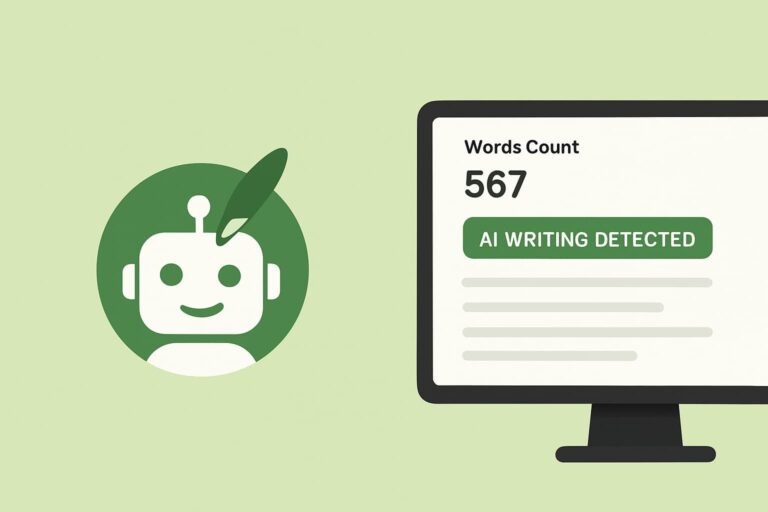Checking for grammar mistakes and clear sentences can be tough. Many people want to write error-free content but do not know where to start. AI paragraph checkers, punctuation checkers, and sentence correctors can help anyone improve their writing quickly and easily.
These tools find mistakes, fix punctuation, and suggest better ways to write sentences. They save time and can make any text look more professional. Users can write emails, essays, and blog posts with more confidence by using these AI writing helpers.
Understanding AI Paragraph, Punctuation, And Sentence Checkers
AI tools for writing can check grammar, fix punctuation, and help with sentence clarity. They make writing clearer and reduce mistakes by analyzing text in different ways.
How AI Language Tools Work
AI language tools use complex algorithms and large sets of data. They scan writing, compare it to rules, and notice errors such as misspelled words, broken sentences, or missing punctuation. Most tools run in real-time. As a person types, the tool highlights issues and offers suggestions for fixes.
Some tools use machine learning, which means they get better as they process more data. Others use set rules and can catch basic errors quickly. The mix of these methods helps AI catch both simple and more complex mistakes.
These tools can also adjust their checks based on style, like formal or casual writing. Some offer extra features like readability scoring or tone suggestions.
Key Differences Between Paragraph, Sentence, And Punctuation Checkers
AI Paragraph Checkers focus on whole paragraphs. They look for structure, flow, and organization. They can spot run-on sections, off-topic sentences, or paragraphs that are too long or too short.
AI Sentence Checkers review single sentences. They check for grammar, clarity, and sentence variety. Sentence checkers help fix awkward wording and improve clarity.
AI Punctuation Checkers zoom in on punctuation marks. They look for missing commas, periods, question marks, and other signs. These tools are helpful for people who struggle with English grammar rules.
| Checker Type | Main Focus | Typical Errors Found |
|---|---|---|
| Paragraph Checker | Structure & flow | Coherence, run-ons, off-topic ideas |
| Sentence Checker | Grammar & clarity | Fragments, awkward phrasing |
| Punctuation Checker | Punctuation marks | Missing/extra marks, incorrect use |
Common Use Cases For AI Grammar Solutions
Students use AI tools to check essays and homework before submitting. This helps catch mistakes teachers might mark down. Professionals use them for emails, reports, and presentations. It ensures writing looks polished and reduces misunderstandings in the workplace.
Content creators, like bloggers, often use AI to improve their writing speed and accuracy. Non-native English speakers rely on these tools to better understand grammar rules and avoid common errors.
These AI solutions save time and help users write with more confidence. They also help teach better writing habits over time.
Core Features Of AI Sentence Checker And Corrector Tools
AI sentence checkers help users find and fix writing mistakes quickly. These tools focus on finding grammar errors, suggesting better ways to write, and making sentences clearer for readers.
Real-Time Error Detection
AI sentence checkers scan text as the user types. This means they can catch mistakes right away instead of waiting until the end. Common errors detected include:
- Spelling mistakes
- Wrong punctuation
- Repeated words
- Simple grammar issues
Most sentence checkers highlight or underline the error so users can make changes immediately. This helps users fix mistakes before sharing or submitting their writing. The quick feedback can also help people improve their own writing habits over time. Some tools let the user customize what types of errors should be flagged for a more personal experience.
Grammar And Syntax Improvements
AI tools are trained to spot errors in grammar and syntax. They check for subject-verb agreement, tense consistency, sentence fragments, and run-ons. The tool points out where a sentence is not following standard rules and gives suggestions for correction.
For example, if a sentence is missing a verb or uses an incorrect tense, the AI will recommend a fix. These suggestions are often simple and easy to understand. Many tools let the user accept, ignore, or learn more about the correction offered.
To help writers improve, some checkers give short explanations. This makes it easier to see why a change is needed, instead of just fixing issues automatically.
Suggestions For Sentence Clarity
AI sentence correctors can suggest ways to make writing clearer and easier to understand. They look for wordiness, unclear wording, and awkward phrasing.
Features include:
- Offering shorter and simpler alternatives to long sentences
- Recommending active voice instead of passive voice
- Pointing out sentences that are confusing or hard to follow
Some tools show a side-by-side comparison in a table to highlight the suggested changes.
| Original Sentence | Suggested Revision |
|---|---|
| She had made a decision that she was going to leave. | She decided to leave. |
These suggestions help users write sentences that are both correct and easy to read.
Benefits And Limitations Of AI Paragraph And Punctuation Checkers
AI tools for checking paragraphs, sentences, and punctuation can help people write better and faster. These digital tools offer many strengths, but they also come with a few drawbacks that users should keep in mind.
Enhancing Writing Accuracy
AI checkers find spelling, grammar, and punctuation mistakes that are easy to miss. They can point out run-on sentences, missing words, and wrong verb forms. This helps writers catch errors before sharing their work.
Many AI tools also highlight sentences that are hard to read. They may suggest replacements for unclear words or offer examples of better phrasing. By following these suggestions, users can make their writing clearer and more reliable.
Most AI checkers now review entire paragraphs for structure. They can show when ideas are out of order or when one part of a paragraph needs more support. Writers can use these features to make their work more logical and easy for others to understand.
Time Efficiency For Content Review
Using an AI checker saves a lot of time compared to checking work by hand. These tools can scan a document and return feedback within seconds. Busy students, teachers, and professionals find this especially helpful.
AI also streamlines the editing process by pinpointing specific issues. Instead of searching for problems line by line, writers get a list of errors and suggestions all in one place. Changes can be made quickly using these automatic corrections.
The quick feedback helps writers meet tight deadlines. It also makes it easier to polish longer texts without spending hours on revision. For teams, some AI tools also allow for real-time group editing and shared access.
Potential Pitfalls And Limitations
AI checkers cannot fully understand meaning or intent. They may give advice that does not fit the topic, context, or style that the writer wants. Sometimes, the suggested corrections are wrong or make the sentence hard to understand.
Writers may get too dependent on AI tools and skip learning grammar rules themselves. This can lead to new mistakes if the AI is off or unavailable. Sensitive information entered into online tools may not be private, so users need to be careful with what they share.
AI systems also struggle with creative writing and complex ideas. For example, tools may not catch sarcasm, jokes, or subtle meanings. As a result, human review is still needed for important or complex documents.
Choosing The Right AI Writing Tool For Your Needs
Different AI writing tools work best in certain situations. Buyers need to think about how a tool works with their devices, how easy it is to use, and how it protects their data.
Compatibility And Integration
Not all AI writing tools are compatible with every device or platform. Some work only on Windows or Mac, while others offer web-based access. Users should check if the tool integrates with programs they already use, such as Microsoft Word, Google Docs, or email clients.
Many tools offer browser extensions, plugins, or APIs. This makes it easier to check paragraphs, sentences, and punctuation in real time. It is helpful to make a list of the software and devices most used and check for compatibility before choosing.
Some tools allow cloud storage for documents. Others may only save files locally. It is important to consider if remote access or teamwork features are needed for group projects.
User Interface And Accessibility
A simple and clear interface matters. Users should be able to find features like paragraph checks, sentence correction, and punctuation review quickly. Some tools use color-coded highlights, side-panel recommendations, or pop-up suggestions for corrections.
Look for options that support different reading levels. Features such as adjustable font size, dark mode, and keyboard shortcuts help users with various needs. Drag-and-drop or copy-paste support makes it quicker to check text.
Mobile compatibility is also important. Some AI tools have apps, while others perform better on desktop browsers. Users with disabilities should check for screen reader support and other accessibility options.
Privacy And Data Security Considerations
AI writing tools often process text by sending it to a server. Sensitive information such as personal, business, or school data may be seen by the service provider. It is important to read the tool’s privacy policy before entering private information.
Look for tools that use encryption during transfer and storage. Some offer end-to-end encryption or local-only options that never upload content to the cloud. Paid tools may promise stronger data protection.
Data retention is also a key factor. Some providers keep user text for a short time, while others store it longer for product improvement. Check if there is an option to delete data after checks. A summary table like the one below makes comparison simple:
| Tool Name | Data Encryption | Local Only Option | Data Retention Policy |
|---|---|---|---|
| Tool A | Yes | Yes | Deletes after 30 days |
| Tool B | Yes | No | Retains for 6 months |
| Tool C | No | Yes | Deletes instantly |




